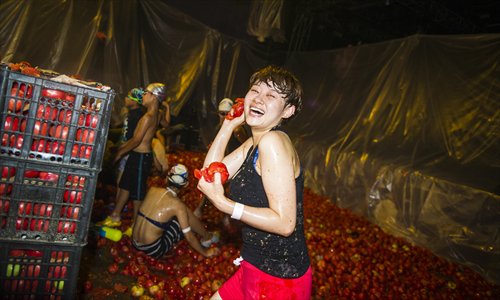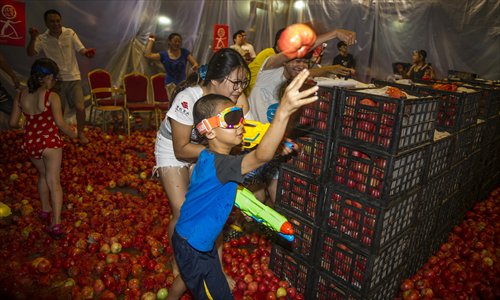Beaten to a pulp
Shuangjing turns into ‘red-fight district’ during Beijing’s first tomato war

A woman prepares to hurl a tomato at Mako Livehouse in Shuangjing, Chaoyang district, on July 6. Around 50,000 tomatoes were used in a food fight at the venue involving more than 1,000 people. Photo: Li Hao/GT
More than 1,000 revelers splattered each other with 10 tons of tomatoes during an six-hour food fight known as Splash Wars on Sunday at Mako Livehouse in Chaoyang district. The smell of fresh tomatoes filled the air as scantily clad foreigners and Chinese pelted each other to the sounds of screams and upbeat music in an event inspired by Spain's famous annual La Tomatina festival.
The battle kicked off at 1 pm with a two-hour skirmish for children ahead of the adults' fight. Divided into two mixed-gender teams, both sides were partially sheltered by bunkers formed using tomato-filled crates.
But the crates were soon used by combatants as shields to protect themselves from flying tomatoes and a shower of juice as they advanced into enemy territory. Some innovative fighters even used crates to scoop up splattered tomatoes to hurl at their opponents.
After the battle wrapped up at 7 pm, participants' skin and clothes were stained red with bits of pulp in their hair and juice dripping from their bodies. But their drenched appearance wasn't just caused by the tomato skirmish, with many taking the opportunity to dive into the "red sea" and give themselves a tomato bath.





Hundreds of people became soaked in juice from 10 tons of tomatoes during Splash Wars at Mako Livehouse in Shuangjing, Chaoyang district, on July 6. For 100 yuan ($16), people were invited to pelt each other with tomatoes purchased from a local wholesale market. Despite some concerns about food waste, event organizers assured the public only tomatoes unsuitable for human consumption were used. The overall response from participants was positive, but some complained about the lack of shower facilities and firmness of tomatoes. Photos: Li Hao/GT
Streets run red
The La Tomatina festival, which has been held every year in the eastern Spanish city of Buñol since 1945, is arguably the world's most famous tomato fight. Expats who competed on Sunday said Beijing's equivalent event lived up to the hype.
"It's like a real war. I am a competitive guy who is here to win, not to lose or die," said Jean Maisonobe. Despite his enthusiasm, it was hard to tell if he and his Chinese friends had been victorious on the day due to their all-red appearance.
"After a week of working hard, it's nice to have this kind of fight," added Maisonobe, a self-described fruit war veteran who has participated in La Tomatina twice and similar food fights in his native France.
Lola Lu was one of the many well-prepared combatants. The 30-year-old came all the way from Fengtai district armed to teeth with a raincoat, waterproof backpack and camera, goggles and bandeau that she and her five friends wore.
But the "bandeau brigade" nevertheless found themselves frequently retreating amid giggles under intense fire on the battlefield. Some resorted to watching the fight from a safe distance on the second floor.
Like all wars, casualties were inevitable. Fortunately, most wounds were to people's pride rather than their bodies, but some people no doubt discovered bruises after washing away splattered tomatoes. "I think almost everybody was hit at least once by a whole tomato. There were some hard, unripe ones flying around. Next time, I'll wait a while until the tomatoes are smashed before going into battle," said Lu.
Three stages of war
Sonic Zhao, a documentary filmmaker, made an attention-grabbing entrance when he and his all-male group strutted in wielding huge water guns. Zhao himself was equipped with a 16-liter portable pesticide sprayer filled with water he purchased especially for the event.
Zhao explained there were three stages of the war. "In the first phase, there were crates of whole tomatoes. In the second phase, the tomatoes were on the ground crushed but could still be thrown. In the third phase, there was only soup," he laughed.
Early in battle, people were warned faces were off-limits. But as the war dragged on, every body part became fair game.
Zhao used ladles to scoop splattered tomatoes from the ground and fling them towards opponents, but his strategy went awry when he was ambushed by rivals who poured tomato stew all over him. In addition to getting in his hair and dripping down his back, some found its way into his mouth.
"I ended up eating some of the soup, which was inevitable. But you cannot think or care about it too much, lest you worry about the fact people's feet, saliva and sweat all came into contact with tomatoes," he laughed.
Waste woes dismissed
Jerry Guo, one of the organizers of Splash Wars, told Metropolitan the event was about "giving people a chance to have fun" and release stress from their daily lives. "People in Beijing are under a lot of pressure, but I believe everybody has an inner child," he said.
The most difficult task for organizers was finding an appropriate location to host the event. On the eve of the battle, Guo and his team were up all night waterproofing Mako Livehouse's main arena using a giant reel of cling wrap.
One of the main criticisms of food fights is the massive waste of food, but Guo said tomatoes used in Splash Wars were rejects bought from Xinfadi Wholesale Market, Fengtai district. The tomatoes were either too soft or rotten, Guo said, making them unfit for sale at the market.
Even the leftover tomatoes from the battle weren't destined for the trash, said Guo. "The remains will be sent to a local pig farm," he said.
Guo, a 26-year-old Chinese-American, said he and his team prepared for Splash Wars by learning from the success of La Tomatina. But there were some noticeable cultural differences between the events, he noted.
"Chinese participants called us to ask what they should wear, and many foreigners challenged us by asking about where the tomatoes were from and whether they would be wasted. Food waste is an issue foreigners tend to care about," he said. "In future, we'll try to make a food-based charity event out of this."
For his part, Zhao said food waste wasn't a key concern on the minds of revelers during their battle. "I don't think this is a waste of food. After all, research needs to be done before people can jump to the conclusion that these tomatoes could solve hunger problems in some poor regions," he said.
Despite being a fun-filled day, Zhao identified some problems that should be tackled by organizers for future events. "The firmness of the tomatoes is a problem. Not all of them could be easily squashed. The first few hits hurt a lot; it was just like being hit by paintball," he said.
Another problem was the lack of showers and pools, which no doubt annoyed subway staff at Shuangjing invaded by a "red army" after the battle. Zhao would also like to see a more innovative battlefield that provided combatants with cover.
"An open arena would be more strategic and provide a lot of places to hide," said Zhao. "It is like going back to the primitive age of plain warfare, but it is still fun!"